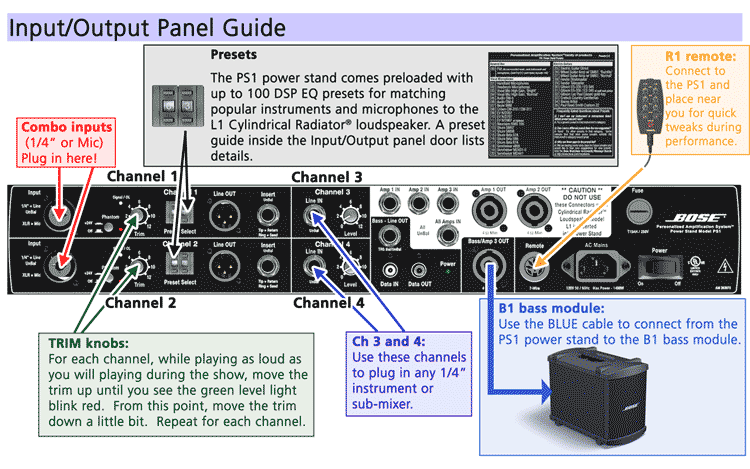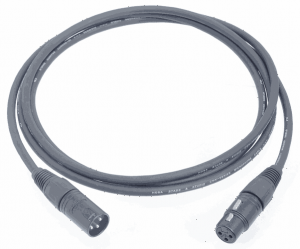Difference between revisions of "PS1 Powerstand Connections"
| Line 8: | Line 8: | ||
=== XLR to XLR === | === XLR to XLR === | ||
| − | [[Image:XLRXLRMF.png|thumb|XLR to | + | [[Image:XLRXLRMF.png|thumb|XLR to XLR, male to female|right]] |
| − | (balanced to balanced) should be fine. | + | (balanced to balanced) should be fine. This is the same kind of cable you would use to connect a microphone. |
| + | |||
Things you can do if the signal is too hot (you are having trouble with the input clipping on the Bose System)... | Things you can do if the signal is too hot (you are having trouble with the input clipping on the Bose System)... | ||
* check to see if there is a 'pad' built-in on the mixer (most Mackie mixers have this on the panel beside the XLR outs) | * check to see if there is a 'pad' built-in on the mixer (most Mackie mixers have this on the panel beside the XLR outs) | ||
Revision as of 17:52, 2 January 2007
PS1 Connections Channels 1 & 2
Contents
Connections from Mixer
This section is an overview of connections you can make from a mixer (mixing desk) to the PS1 Power Stand (Classic) / Model I. For specific examples see: Mixers.
XLR to XLR
(balanced to balanced) should be fine. This is the same kind of cable you would use to connect a microphone.
Things you can do if the signal is too hot (you are having trouble with the input clipping on the Bose System)...
- check to see if there is a 'pad' built-in on the mixer (most Mackie mixers have this on the panel beside the XLR outs)
- turn down the main outs on the mixer
- use a 20 dB Pad (attenuator) between the mixer and the Bose System.
¼ Inch Tip-Ring to ¼ Inch Tip-Ring
(unbalanced to unbalanced) is fine: You could have difficulty if you are running long lines (and losing signal or picking up noise). If you are, consider using shorter cable runs, or running an balanced line. To do this you can use a short unbalanced cable to a DI (to convert from unbalanced to balanced) and run from there: XLR to XLR (balanced to balanced) to the Bose System.
XLR (balanced) to ¼ Inch Tip-Ring-Sleeve (balanced)
This doesn't do much for you. This is because the ¼ Inch input on the Bose System is Tip-Ring (unbalanced) anyway.
Other (not Mixer)
¼ Inch Tip-Ring-Sleeve balanced to XLR balanced
Specialized instrument cable (probably Guitar)
This is probably a specialty cable that was supplied with the instrument. It is intended for a microphone input on a mixer. This should work fine with the Bose System.
Female XLR to ¼ Inch Tip-Ring
Microphone adapter
This will probably not work very well. Sometimes you see these being used for home karaoke machines. These are not suitable for professional use. The ¼ Inch input was designed for high impedance line-level inputs and may not provide enough gain for a microphone which is probably low impedance.
¼ Inch Tip-Ring (unbalanced) to XLR (balanced)
Instrument adapter
This may not work particularly well. You are probably running an impedance mismatch (high impedance from the instrument to low impedance balanced XLR).
This page was originally posted in the Bose® Musicians Community Message Boards
PS1 Powerstand I/O Panel (Interactive Display)


